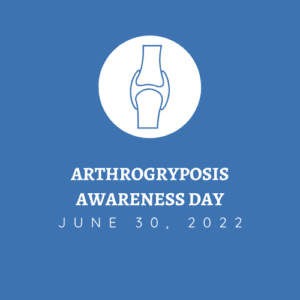Arthrogryposis Multiplex Congenita (AMC)
What is arthrogryposis multiplex congenita (AMC)?
Arthrogryposis multiplex congenita (AMC) refers to the development of multiple joint contractures affecting two or more areas of the body prior to birth. A contracture occurs when a joint becomes permanently fixed in a bent or straightened position, which can impact the function and range of motion of the joint and may lead to muscle atrophy. AMC is not a specific diagnosis, but rather a physical symptom that can be associated with many different medical conditions. Two of the most common forms of AMC are amyoplasia and a group of genetic disorders called the distal arthrogryposes.What are the symptoms of arthrogryposis multiplex congenita (AMC)?
The most common universal symptom of AMC is limited or absent movement around small and large joints (contractures). The muscles of the affected limbs may be underdeveloped (hypoplastic), resulting in a tube-shaped limb with a soft, doughy feeling. Soft tissue webbing may develop over the affected joints. In addition to joint abnormalities, other findings include:- Abnormally slender and fragile long bones of the arms and legs and cleft palate
- Undescended testicles in males
- Structural or functional abnormalities of the central nervous system
What causes arthrogryposis multiplex congenita (AMC)?
There are many causes of AMC, some of which are inherited. Before birth, four possibilities exist that limit joint movements:- Abnormal development of muscles
- Inadequate room in the uterus for the baby
- A malformed central nervous system and spinal cord
- Tendons, joints, bones, and joint linings which did not mature correctly
How is arthrogryposis multiplex congenita (AMC) diagnosed?
A diagnosis of AMC is made based upon identification of characteristic symptoms, a detailed patient history, and a thorough clinical evaluation. Specific tests to confirm diagnosis may include a muscle biopsy and electromyography.What are the treatments for arthrogryposis multiplex congenita (AMC)?
The treatment of AMC is directed toward the specific findings that are apparent in each individual. Standard physical therapy, which can improve joint motion and avoid muscle atrophy in the newborn period is beneficial.Where can I find out more about arthrogryposis multiplex congenita (AMC)?
Arthrogryposis Multiplex Congenita (AMC) Articles





Arthrogryposis Multiplex Congenita Awareness Day is on June 30th
James Moore
June 28, 2022
Read More »

These Organizations Want to Give an Adaptive Bicycle to Every Disabled Child
Rose Duesterwald
August 19, 2020
Read More »

The European Parliament is Relaunching their Network for Rare Diseases
Trudy Horsting
March 20, 2020
Read More »

For This Woman With Arthrogryposis Multiplex Congenita, This New Barbie is Life-Changing
James Moore
February 22, 2019
Read More »






